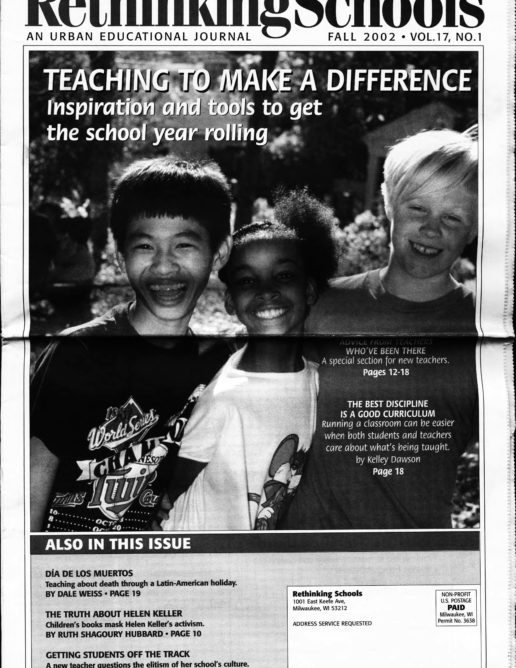Best Discipline is Good Curriculum
Running a classroom can be easier when both students and teachers care about what's being taught
Illustrator: Susan Ruggles

– photo: Susan Ruggles
During my first year of teaching, I tried everything to get my students to behave. Behavior charts, individual plans. Class incentives. Class consequences. Tricks, incentives, threats. Rewards, punishments. Strict attitude, friendly attitude. Yelling, reasoning, sweet-talking, pleading for sympathy.
One day, I wrote the word “celebration” on the board and promised the class they could have a party if they behaved for the whole day. I crossed each letter off one by one. By noon we all knew they’d never make it.
In short, I was desperate.
Discipline is an exhausting part of the job that never really goes away. The message that most of us get is that to be a good teacher, you must first be a good disciplinarian. You must control your students’ behavior. Only then, when your classroom is under control, can you begin to teach.
I disagree.
No teacher has to wait until the students are “under control” to start teaching them worthwhile stuff. It’s actually the other way around. Over and over again, I have found that the moment I start to teach interesting, engaging content, I experience immediate relief in the area of discipline.
During my first year, my classroom was pretty wild. (Don’t hold it against me; I know you’ve been there!) But it made sense to me that my students acted the way they did. I was a brandnew teacher, totally inexperienced. My students wanted more than I could offer them, and they were bored and confused much of the time. I didn’t really see how forcing them to behave would change that.
It took some time, but eventually I quit working so hard at controlling my students’ behavior and started focusing on my own: What was I teaching? What methods was I using? What was I doing to engage, to teach students so that they would not be bored and disruptive?
I looked at what I was doing in social studies: plodding through a textbook that was inaccurate, boring, and disconnected from my students’ lives. I decided to teach some lessons about the civil-rights movement, and to have the class write and perform a play about the Montgomery bus boycott. It was an extremely rough first attempt at writing and teaching my own curriculum, but for our purposes, it worked. I was engaged, the students were engaged, and we all spent a lot less time dealing with discipline.
In my second and third years of teaching, I’ve had similar experiences. Every time there’s a slump in my teaching – yes, even though I work hard, it happens – kids get bored (I get bored, for that matter) and discipline gets hairy. It’s like a rumbling that slowly turns to a roar and ultimately demands action: If you don’t plan some good curriculum, things are really going to get out of control here.
Of course, it’s important to have rules and consequences, and to apply them consistently while teaching interesting content. I find it works well to remind kids frequently why an ordered environment helps them learn, to show them how rules and consequences help create a classroom where real learning can happen. Also, when I’m teaching something I really believe is worth my students’ time, I feel much more authority to demand a high standard of behavior.
Even the best curriculum can’t magically solve all behavior issues. Our society creates a lot of pressures and problems for kids, and they often bring these to school. Students witness violence, live in poverty, struggle to help hardworking parents, and watch a ton of TV, much of it inappropriate. Some students have serious problems that will not go away without specific intervention. It may help to work with the school psychologist, social worker, or administrators in these cases. Teachers can also push for school-wide preventive programs like anti-bullying, anger management or peer mediation. These can have a great impact on behavior.
I’m now in my fourth year of teaching, and I’m still struggling to create all the curriculum I need to motivate and engage my fourth graders for six hours a day. Whenever I feel overwhelmed by the size of that task, I try to remind myself to think small: I go back to my first year and remember that back then, even one good lesson was sometimes enough to tip the scales from boring, intolerable, and out of control to what I could at least call “manageable.”
Each year, I am building upon those lessons and offering better and better curriculum to my students. I know discipline issues will never completely disappear from my classroom. But I also know good curriculum goes a long way toward making my classroom run smoothly. And engaging curriculum is more than just a fix for behavior headaches. It can also get kids to think deeply, care about our world, and help them learn to make positive changes.
As a bonus, I feel less foolish now that I don’t have to stand at the front of the class and take away my students’ celebration one letter at a time.

